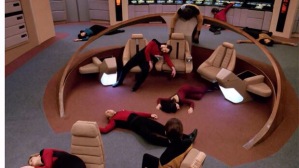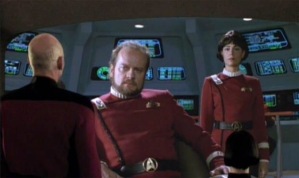When you watch a lot of science fiction, there tend to be certain “tropes” and storylines that are repeated throughout almost universally. And when you’re a franchise as big as Star Trek, some of your episodes reuse or remake these tropes within a series or within a season. In TNG, Clues (S:4, E:14), Conundrum (S:5, E:14), and Cause and Effect (S:5, E:18) are all a variation on a theme: the crew has lost their memory and must try to figure out what exactly is going on. Each episode handles it a little bit differently, but in my mind, they are inextricably linked. In part, I think that is because of the similarities in their plots and themes, but mostly, I think it’s because they all have episode titles that start with “C.” (Hence the title of the blog post)
With all of these episodes coming in a pretty quick succession, I thought it might be time to delve into the unique aspects of each of these episodes. Each one tells a story that is simultaneously unique an engaging, and though they can easily be lumped together as “the three where they lose their memories,” or some such summation, they aren’t the same episode. In some ways, they highlight many of Star Trek’s individual strengths.
Clues
The bridge crew collapses at the beginning of Clues. (Photo Credit: DenofGeek)
The first of these episodes, Clues, comes along in season 4, and it is certainly the one that holds up the worst on subsequent viewings. The mystery is relatively intriguing, but once you know the punchline, the joke sort of falls flat.
The premise is simple: An approaching phenomenon causes the crew of the Enterprise to pass out for approximately thirty seconds. However, as members of the Crew try to reorient themselves, there are certain things that show that they were unconscious for much longer than 30 seconds. Experiments have progressed too quickly, Worf has a broken wrist, and so on. To top it all off, Data is acting extremely strange, and it becomes clear that he’s hiding something.
For a few minutes, we’re lead to believe Data may be part of a devious conspiracy. It turns out that the Enterprise has met an extremely Xenophobic alien race, and the race threatened to kill the Enterprise solely for encountering them in order to secure their solitude. Therefore, the crew essentially agreed to wipe their memories and continue forward without any knowledge of the alien race. Data, of course, could not have his memory wiped and therefore has been ordered not to ever tell anyone on the crew what occurred.
Like I said initially, Clues has a sufficiently interesting mystery, but it doesn’t really hold up on subsequent viewings. As soon as the crew starts looking for “clues” to figure out why more than 30 seconds have passed, the mystery kind of drops out. I love the premise, and the execution is great. Season 4 has Data taking over the Enterprise pretty early on in Brothers. So, having him held up as the possible villain seems believable.
The problem, however, is that the logical holes in the episode seem like the Grand Canyon on those second viewings. Though the crew purports to “fix” the clues that had been left the first times their memories were wiped, many of those flaws remain. Worf’s wrist is still broken, and there is nothing they can do to adjust the huge discrepancy that will certainly be on their chronometer when they return to a starbase or encounter another ship.
These holes don’t entirely ruin the episode, but they are certainly examples of why Clues doesn’t quite hold up on subsequent viewings. It is fine, but it isn’t a paragon of great storytelling or great science fiction.
Conundrum
Troi and Data compete in 3D chess at the beginning of Conundrum. (Photo credit: TreksInSciFi.com)
Conundrum is similar to Clues in that it deals with the loss of memory and a potentially devious individual whose motives aren’t revealed immediately. In Conundrum, the crew members lose their memories. While they clearly still have their personalities and skills, they do not have memories of their specific identities. Thus, Data, who was fixing a drink for Troi behind the bar in Ten Forward, thinks he’s a bartender while the rest of the crew members, in their various locations, are entirely unsure of their identies and roles on the ship.
It turns out that a previously unheard of alien race (the Satarrans) had wiped the memories of the Enterprise crew, placing an individual named “Commander MacDuff” in the middle of the Bridge in order to guide their exploration. This race, in the middle of a war against a race called the Lysians, wanted to use the Enterprise to bring the Federation into their war in order to gain a competitive advantage against their enemy.
It is only because the crew of the Enterprise is moral and intelligent even without their memories that they don’t wipe out the Lysians Central Command with the press of a button. No one on the Enterprise is ever out for bloodlust, and even with purported orders from Starfleet, Picard and the rest of the crew are hesitant to destroy a station that seems so defenseless.
The thing that stands out most to me in this one is the characters. Their minds have been wiped. Completely. They don’t know their identities. I mean, Data thinks he’s a bartender. But the characters don’t really change. When Riker suggests that Picard might be in charge (because of his pips), Worf counters that he, too, is decorated. Picard, of course, doesn’t care about titles or ranks and merely stresses that they must work together to solve the mystery. It isn’t important who is in charge.
We also see a wonderful hint of the Troi and Riker relationship. Despite the loss of their memories and identities, these two have a very obvious connection that carries through. Of course, Riker pretty much screws this up by sleeping with an extremely forward Ensign Ro, but it is a lovely reminder of the fact that they are “Imzadi” to each other.
Conundrum, I think, is one of those episodes that only work if you are already intimately familiar with the series. It is full of breadcrumbs for hardcore fans to recognize, and it relies heavily on a deep understanding of the characters and their positions on the ship in order to develop the story and the mystery. For me, however, that makes Conundrum an entertaining episode to watch. It is no secret that I love the characters on TNG, and an episode that relies exclusively on the personality of the characters really draws me in.
Cause and Effect
Picard speaks with Captain Morgan Bateson of the USS Bozeman. (Photo Credit DenOfGeek)
Certainly my favorite of these episodes, Cause and Effect deals with a time when the Enterprise is stuck in a time loop that ends with the destruction of the ship every time. Think Groundhog Day except the crew doesn’t really know they are stuck in a loop.
While the crew is generally unaware that they are stuck in such a loop, certain members do experience vague feelings of deja vu as they go along. Crusher, for one, seems to recognize that they’ve had these same conversations before while she treats Geordi in sickbay and when she’s playing poker with other crew members. Ultimately, the solution is that they realize that they’re stuck in a temporal loop and reprogram Data so that the number three appears over and over, and he realizes that that means they must pick to use Riker’s solution (three pips) at the end to save the Enterprise.
After they break the temporal loop, the Enterprise meets the USS Bozeman (captained by none other than Frasier himself, Kelsey Grammar). Unbeknownst to them, the crew of the Bozeman had been stuck in the same temporal loop for 90 years.
Of these three episodes, Cause and Effect is definitely the one that should hold up the least. Ultimately, it consists of the same handful of scenes played four or so times over the course of the episode. It should seem repetitive and boring, and it definitely shouldn’t be one that warrants multiple viewings.
But Cause and Effect is expertly directed and expertly written. While it is extremely repetitive, Jonathan Frakes takes extreme care to shoot and direct each scene so that they are essentially the same but with different defining features. Watching the crew explore these differences and begin to slowly understand what has caused these feelings of deja vu is endlessly interesting.
I’m not sure what it is, specifically, that makes Cause and Effect stand out as the clear winner of these three episodes for me. It is not as if I dislike the other two, but this one just seems to hold up more. Perhaps some of it is the directing. I love Frakes’s skill as a director, and I’m sure he has put touches on this episode I don’t even recognize. Plus, the mystery seems more organic and intriguing. I think that may be because, for the most part, the crew doesn’t realize they have a mystery they need to solve. Thus, the mystery evolves organically, and it doesn’t become something the audience sees right away.
**
Like I said above, these three episodes are inextricably linked in my mind. Of course, as I sit down to write about them and compare them, I’m struck more by their differences than their similarities. Though they can all be grouped together by their singular connection (lost memory), they really stand on their own as unique ways to use a trope without feeling repetitive. I suppose that’s what science fiction, and even Star Trek, is all about.
After all, don’t they always say that the plot of every TNG episode is just one long committee meeting?
(I kid. Mostly…)
#LLAP



One thought on “The One With The Three C’s…”